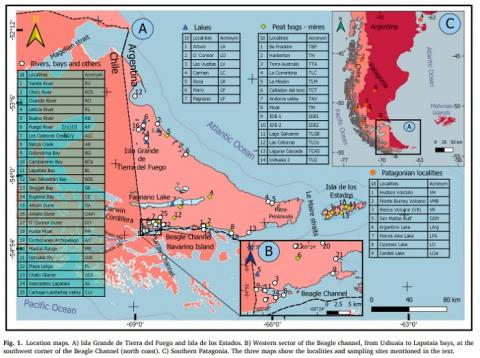Andrea Coronato, Ana María Borromei, Juan Federico Ponce, Soledad Candel, Lorena Musotto, Marilén Fernández, Cecilia Laprida, Adriana Mehl, Alejandro Montes, Cristina San Martín, Adolfina Savoretti,
Gabriela Cusminsky, Sandra Gordillo, María Julia Orgeira, Ramiro López, Pamela Alli, Diego Quiroga
Gabriela Cusminsky, Sandra Gordillo, María Julia Orgeira, Ramiro López, Pamela Alli, Diego Quiroga
2 022
Journal of South American Earth Sciences Volume 119 , November 2022
Environmental changes were reconstructed from a multiproxy synthesis of over 30 localities from the Isla Grande de Tierra del Fuego and Isla de los Estados, southernmost South America. At a local scale, the results from the mountain forest and gently undulating steppe areas were integrated as well as those from the marine environments of the Beagle Channel and the Atlantic coasts. At a regional scale, the results were integrated with those published for the southernmost Andean and Extra-Andean Patagonia and the Antarctic Peninsula. This study focuses on the environmental evolution during the Late Glacial-Holocene transition, the Middle to Late Holocene transgressive-regressive hemicycle and wet-dry oscillations, the Medieval Climate Anomaly, the Little Ice Age, the tephra inputs from the Patagonian Andes, and the recent climatic warming. Most paleoenvironmental changes are related to variations in the latitudinal position and intensity of the Southern Westerly Winds (SWW) while others are associated with astronomical or endogenous forcings. At a strong intensity of the SWW, a greater contribution of humidity to the forest areas and an increase in the rainfall gradient create windy and arid conditions in the steppe. At a weak intensity of the SWW, lower humidity input in the forest areas and the advection of air masses from the Atlantic Ocean promoted humid and slightly windy conditions in the steppe. Similar environmental trends are observed between terrestrial and marine environments in the center and south of Tierra del Fuego, Isla de los Estados and the Antarctic Peninsula, and between the Fuegian steppe and Extra-Andean Patagonia. The paleoclimatic evidence reveal high environmental variability in the last 10,000 years for this sector of the Southern Hemisphere.

